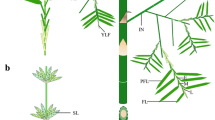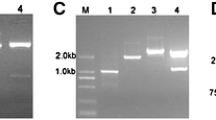Abstract
Bamboos are versatile multipurpose forest products that are so important economically that they are often referred to as “green gold”. With the development of modern gardens, bamboos have become one of the main garden plants because of their unique aesthetic beauty. However, flowering usually causes bamboo to die. To explore the genetic and molecular mechanisms that underlie the transition from the vegetative to reproductive stage in bamboos, two FT-like genes, PvFT1 and PvFT2, were identified in a bamboo species (Phyllostachys violascens). The cDNA sequences of PvFT1 and PvFT2 consisted of 962 bp and 890 bp, respectively, and each encodes 178 amino acids. These two proteins belonged to the PEBP family and contained a Tyr residue that is critical to differentiate FT and TFL1. Like other florigen, PvFT1 is expressed only in the leaves and reached its highest level 20 to 30 days before flowering. It’s transcript is not detected in those plants that never flowered, while PvFT2 mRNA is observed only in spikelet. PvFT1 transcript accumulation was diurnally expressed with a peak at dusk. Constitutive expression of full-length PvFT1 in rice cause early flowering relative to wild-type and in vitro, 50 % of shooting plants displayed structures that resembled floral organs. Our results suggested that PvFT1 might be a candidate gene for florigen and played a role in the induction of bamboo flowering, while PvFT2 might be involved in the development of floral organs. This information could lead to a better understanding of the mechanisms involved in bamboo flowering.






Similar content being viewed by others
Abbreviations
- FT:
-
Flowering locus T
- PEBP:
-
Phosphatidylethanolamine-binding protein
- Hd3a:
-
Heading date 3a
- AP1 :
-
APETALA1
- RFT1:
-
Rice flowering locus T1
References
Abe M, Kobayashi Y, Yamamoto S, Daimon Y, Yamaguchi A, Ikeda Y, Ichinoki H, Notaguchi M, Goto K, Araki T (2005) FD, a bZIP protein mediating signals from the floral pathway integrator FT at the shoot apex. Science 309:1052–1056
Ahn JH, Miller D, Winter VJ, Banfield MJ, Lee JH, Yoo SY, Henz SR, Brady RL, Weigel D (2006) A divergent external loop confers antagonistic activity on floral regulators FT and TFL1. EMBO J 25:605–614
An HL, Roussot C, Suarez-Lopez P, Corbesier L, Vincent C, Pineiro M, Hepworth S, Mouradov A, Justin S, Turnbull C, Coupland G (2004) CONSTANS acts in the phloem to regulate a systemic signal that induces photoperiodic flowering of Arabidopsis. Development 131:3615–3626
Baurle I, Dean C (2006) The timing of developmental transitions in plants. Cell 125:655–664
Blackman BK, Strasburg JL, Raduski AR, Michaels SD, Rieseberg LH (2010) The role of recently derived FT paralogs in sunflower domestication. Curr Biol 20:629–635
Bo¨ hlenius H, Huang T, Charbonnel-Campaa L, Brunner AM, Jansson S, Strauss SH, Nilsson O (2006) CO/FT regulatory module controls timing of flowering and seasonal growth cessation in trees. Science 19:1040–1043
Chardon F, Damerval C (2005) Phylogenomic analysis of the PEBP gene family in cereals. J Mol Evol 61:579–590
Chen CY, Hsieh MH, Yang CC, Lin CS, Wang AY (2010) Analysis of the cellulose synthase genes associated with primary cell wall synthesis in Bambusa oldhamii. Phytochemistry 71:1270–1279
Corbesier L, Vincent C, Jang S, Fornara F, Fan Q, Searle I, Giakountis A, Farrona S, Gissot L, Turnbull C (2007) FT protein movement contributes to long-distance signaling in floral induction of Arabidopsis. Science 316:1030–1033
Danilevskaya ON, Meng X, Ananiev EV (2010) Concerted modification of flowering time and inflorescence architecture by ectopic expression of TFL1-like genes in maize. Plant Physiol 153:238–251
Doyle JJ, Doyle JL (1987) A rapid DNA isolation procedure for small quantities of fresh leaf tissue. Phytochem Bull 19:11–15
Endo T, Shimada T, Fujii H, Kobayashi Y, Araki T, Omura M (2005) Ectopic expression of an FT homolog from Citrus confers an early flowering phenotype on trifoliate orange (Poncirus trifoliata L.Raf.). Transgenic Res 14:703–712
Guindon S, Guindon O (2003) A simple, fast, and accurate algorithm to estimate large phylogenies by maximum likelihood. Syst Biol 52:696–704
Hanzawa Y, Money T, Bradley D (2005) A single amino acid converts a repressor to an activator of flowering. Proc Natl Acad Sci U S A 102:7748–7753
Hecht VR, Laurie RE, Schoor JKV, Ridge S, Knowles CL, Liew LC, Sussmilch FC, Murfet IC, Macknight RC, Weller LJ (2011) The pea GIGAS gene is a FLOWERING LOCUS T homolog necessary for graft-transmissible specification of flowering but not for responsiveness to photoperiod. Plant Cell 23:147–161
Hiei Y, Ohta S, Komari T, Kumashiro T (1994) Efficient transformation of rice (Oryza sativa L.) mediated by Agrobacterium and sequence analysis of the boundaries of the T-DNA. Plant J 6:271–282
Hsu CY, Liu Y, Luthe DS, Yuceer C (2006) Poplar FT2 shortens the juvenile phase and promotes seasonal flowering in poplar trees. Plant Cell 18:1846–1861
Ingham DJ, Beer S, Money S, Hansen G (2001) Quantitative real time PCR assay for determining transgene copy number in transformed plants. Biotechniques 31:132–140
Jaeger KE, Wigge PA (2007) FT protein acts as a long-range signal in Arabidopsis. Curr Biol 17:1050–1054
Kardailsky I, Shukla VK, Ahn JH, Dagenais N, Christensen SK, Nguyen JT, Chory J, Harrison MJ, Weigel D (1999) Activation tagging of the floral inducer FT. Science 286:1962–1965
Kojima S, Takahashi Y, Kobayashi Y, Monna L, Sasaki T, Araki T, Yano M (2002) Hd3a, a rice ortholog of the arabidopsis FT gene, promotes transition to flowering downstream of Hd1 under short-day conditions. Plant Cell Physiol 43:1096–1105
Komiya R, Ikegami A, Tamaki S, Yokoi S, Shimamoto K (2008) Hd3a and RFT1 are essential for flowering in rice. Development 135:767–774
Kumar S, Tamura K, Nei M (2004) MEGA3: integrated software for molecular evolutionary genetics analysis and sequence alignment. Brief Bioinform 5:150–163
Kumiko M, Hidefumi Y, Masaaki Y, Kinji T, Hiroaki Y (2001) Manufacture and properties of fiberboard made from moso bamboo. J Jpn Wood Res Soc 47:111–119
Lee R, Baldwin S, Kenel F, McCallum J, Macknight R (2013) FLOWERING LOCUS T genes control onion bulb formation and flowering. Nat Commun 4:2884. doi:10.1038/ncomms3884
Li C, Dubcovsky J (2008) Wheat FT protein regulates VRN1 transcription through interactions with FDL2. Plant J 55:543–554
Lifschitz E, Eviatar T, Rozman A, Shalit A, Goldshmidt A, Amsellem Z, Alvarez JP, Eshed Y (2006) The tomato FT ortholog triggers systemic signals that regulate growth and flowering and substitute for diverse environmental stimuli. Proc Natl Acad Sci U S A 103:6398–6403
Lin M, Belanger H, Lee Y, Varkonyi-Gasic E, Taoka K, Miura E, Xoconostle-Cázares B, Gendler K, Jorgensen RA, Phinney B (2007) FLOWERING LOCUS T protein may act as the long-distance florigenic signal in the cucurbits. Plant Cell 19:1488–1506
Lin EP, Peng HZ, Jin QY, Deng MJ, Li T, Xiao XC, Hua XQ, Wang KH, Bian HW, Han N, Zhu MY (2009) Identification and characterization of two Bamboo (Phyllostachys praecox) AP1/SQUA-like MADS-box genes during floral transition. Planta 231:109–120
Lin XC, Chow TY, Chen HH, Liu CC, Chou SJ, Huang BL, Kuo CI, Wen CK, Huang LC, Fang W (2010) Understanding bamboo flowering based on large-scale analysis of expressed sequence tags. Genet Mol Res 9:1085–1093
Mathieu J, Warthmann N, Küttner F, Schmid M (2007) Export of FT protein from phloem companion cells is sufficient for floral induction in Arabidopsis. Curr Biol 17:1055–1060
Meng X, Muszynski MG, Danilevskaya ON (2011) The FT-Like ZCN8 gene functions as a floral activator and is involved in photoperiod sensitivity in maize. Plant Cell 23:942–960
Mouradov A, Cremer F, Coupland G (2002) Control of flowering time: interacting pathways as a basis for diversity. Plant Cell 14:S111–S130
Nath AJ, Das G, Das AK (2009) Above ground standing biomass and carbon storage in village bamboos in North East India. Biomass Bioenergy 33:1188–1196
Navarro C, Abelenda JA, Cruz-Oro’ E, Cue’llar CA, Tamaki S, Silva J, Shimamoto K, Prat S (2011) Control of flowering and storage organ formation in potato by FLOWERING LOCUS T. Nature 48:119–123
Oda A, Narumi T, Li T, Kando T, Higuchi Y, Sumitomo K, Fukai S, Hisamatsu T (2012) CsFTL3, a chrysanthemum FLOWERING LOCUS T-like gene, is a key regulator of photoperiodic lowering in chrysanthemums. J Exp Bot 63:1461–1477
Peng ZH, Lu Y, Li LB, ZhaoQ FQ, Gao ZM, Lu HY, HuT YN, Liu KY, Li Y, Fan DL, Guo YL, Li WJ, Lu YQ, Weng QJ, Zhou CC, Zhang L, Huang T, Zhao Y, Zhu CR, Liu XG, Yang XW, Wang T, Miao K, Zhuang CY, Cao XL, Tang WL, Liu GS, Liu YL, Chen J, Liu ZJ, Yuan LC, Liu ZH, Huang XH, Lu TT, Fei BH, Ning ZM, Han B, Jiang ZH (2013) The draft genome of the fast-growing non-timber forest species moso bamboo (Phyllostachys heterocycla). Nat Genet 45:456–461
Purwestri YA, Ogaki Y, Tamaki S, Tsuji H, Shimamoto K (2009) the 14-3-3 protein GF14c acts as a negative regulator of flowering in rice by interacting with the florigen Hd3a. Plant Cell Physiol 50:429–438
Tamaki S, Matsuo S, Wong HL, Yokoi S, Shimamoto K (2007) Hd3a protein is mobile flowering signal in rice. Science 316:1033–1036
Taoka K, Ohki I, Tsuji H, Furuita K, Hayashi K, Yanase T, Yamaguchi M, Nakashima C, Purwestri YA, Tamaki S, Ogaki Y, Shimada C, Nakagawa A, Kojima C, Shimamoto K (2011) 14-3-3 proteins act as intracellular receptors for rice Hd3a florigen. Nature 476:332–337
Tian B, Chen Y, Yan Y, Li DZ (2005) Isolation and ectopic expression of a bamboo MADS-box gene. Chin Sci Bull 50:217–224
Tian B, Chen Y, Li DZ, Yan Y (2006) Cloning and characterization of a bamboo Leafy Hull Sterile1 homologous gene. DNA Seq 17:143–151
Wigge PA, Kim MC, Jaeger KE, Busch W, Schmid M, Lohmann JU, Weigel D (2005) Integration of spatial and temporal information during floral induction in Arabidopsis. Science 309:1056–1059
Xu H, Chen LJ, Qu LJ, Gu HY, Li DZ (2010) Functional conservation of the plant EMBRYONIC FLOWER2 gene between bamboo and Arabidopsis. Biotechnol Lett 32:1961–1968
Zhang XM, Zhao L, Larson-Rabin Z, Li DZ, Guo ZH (2012) De Novo sequencing and characterization of the floral transcriptome of Dendrocalamus latiflorus (Poaceae: Bambusoideae). PLoS ONE 7, e42082
Acknowledgments
The authors thank two anonymous reviewers for critical reading and also thank Dr. Xuerong Shi for his critical reading of the manuscript. This work was supported by grant from the National Natural Science Foundation of China (grant no. 30901155), grant from the National Program on Key Basic Research Project (973 Program) (2012CB723008) and grant of Natural Science Foundation of Zhejiang Province (grant no. Y307499).
Author information
Authors and Affiliations
Corresponding author
Additional information
Xiaoqin Guo and Yi Wang contributed equally to this work.
Rights and permissions
About this article
Cite this article
Guo, X., Wang, Y., Wang, Q. et al. Molecular characterization of FLOWERING LOCUS T(FT)genes from bamboo (Phyllostachys violascens). J. Plant Biochem. Biotechnol. 25, 168–178 (2016). https://doi.org/10.1007/s13562-015-0322-x
Received:
Accepted:
Published:
Issue Date:
DOI: https://doi.org/10.1007/s13562-015-0322-x




